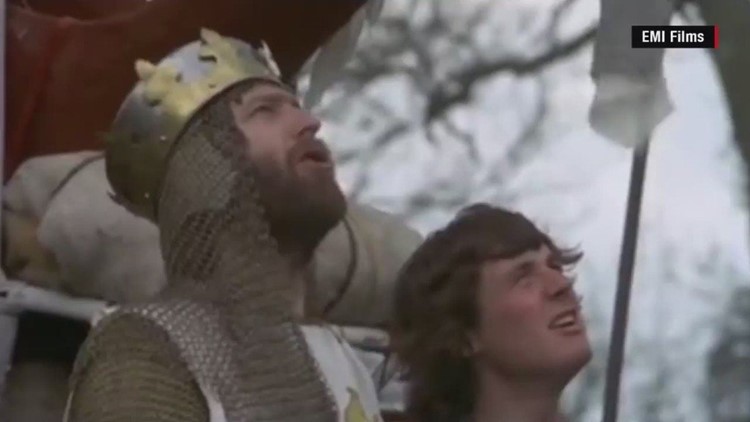(CNN) — Monty Python in a movie?
What a silly idea.
But the timing was right for the gang of British comedians (along with their token American, Terry Gilliam), who were looking to hit the big screen after four seasons of “Monty Python’s Flying Circus,” their groundbreaking British TV series.
“Monty Python and the Holy Grail,” which premiered 40 years ago Thursday, was the result.
The movie, a spoof of the Arthurian legend, did not start auspiciously.
The budget was small — about $400,000, half of it supplied by rock stars, including Genesis and Pink Floyd. On the first day of filming in Scotland — the first shot, in fact — the camera broke. The weather was bad. The hotel was dismal. Python member Graham Chapman was suffering from alcohol withdrawal.
It got better.
On the day of its first American screening in New York, a thousand people were in line by 8 a.m. Thanks to the popularity of “Python” on American TV, the movie was a box-office hit, making $5 million — more than 10 times its budget.
More importantly, it soon became a comedy classic. The dialogue alone has been widely quoted, with such lines as “It’s just a flesh wound” and “Your mother was a hamster and your father smelt of elderberries” referenced on shows such as “The Simpsons,” “Game of Thrones” and “The Blacklist.” Python member Eric Idle turned the film into the Tony-winning Broadway play “Spamalot.”
The troupe ended up making three movies — well, four, if you count “And Now for Something Completely Different,” five if you include “Monty Python Live at the Hollywood Bowl,” five-and-a-half if you allow “The Rutles,” six if you … well, three. We’ll say three.
Is there a best one? Where should you start?
Let’s break them down:
“Monty Python and the Holy Grail” (1975)
From its dramatic opening credits featuring fake-Swedish subtitles to the adventures of Sir Launcelot (“the boldest and most expensive of the knights”), weighted-bird computations and sudden animator heart attacks, “Holy Grail” is probably the loosest and most Python-esque of the Python oeuvre.
As a movie with a plot and character and all that movie nonsense, it falls short — but as a repository for some of Python’s best gags, it remains perhaps the best (and certainly most quotable) of the bunch. Besides, it features the word “shrubbery.”
” ‘Grail’ is a bit like ‘A Hard Day’s Night,’ ” Idle observed in the Pythons’ autobiography. “It’s got a joie de vivre that’s very infectious, it’s very hard not to like.”
Pros: The dialogue. The Black Knight. The Knights Who Say “Ni.”
Cons: It’s sometimes sloppy. And it doesn’t really have an ending.
Verdict: Better than a cheese shop full of ex-parrots.
“Monty Python’s Life of Brian” (1979)
Probably Python’s most consistent movie, “Life of Brian” is the story of a guy born down the road from Jesus who finds himself hailed as a messiah and ends up crucified.
It was a satire on organized religion, first-century politics and zealotry — one of the best bits is the ongoing argument between “the People’s Front of Judea” and “the Judean People’s Front” — but try telling that to the protesters. The film was picketed in cities across the United States, deplored by some religious leaders and banned in Ireland and Norway. (Sweden promoted it with the line, “The film so funny that it was banned in Norway.”)
It did have one huge supporter: ex-Beatle George Harrison, who mortgaged his estate to help fund the movie when a financier pulled out. “He paid for it because he wanted to see it,” Idle recalled. “The most anybody’s ever paid for a cinema ticket in history.”
Pros: Graham Chapman’s performance as Brian. “What have the Romans ever done for us?” “Always Look on the Bright Side of Life.”
Cons: The adventurous but ultimately pointless animated-alien scene. Michael Palin’s lisping Pilate (though, to be fair, it’s so childishly broad you can’t help but laugh).
Verdict: Funnier than the Spanish Inquisition.
“Monty Python’s Meaning of Life” (1983)
“Meaning of Life,” constructed as a series of sketches, is the most uneven of the three narrative Python films.
After the stunning opening sequence, Gilliam’s “The Crimson Permanent Assurance” — about the revenge of some pirate-like accountants — the film struggles to find its footing.
Even the Pythons thought so. “The rhythms weren’t right,” said Gilliam. “It needed a whole other rewrite,” said Idle.
Nevertheless, it has its moments: the “Every Sperm Is Sacred” sequence, about religion, sex and contraception; the organ donor who’s surprised by a demand for his liver; and — of course — the infamous Mr. Creosote, the absurdly fat man who gorges on a monstrous meal at a posh restaurant, regurgitates it at length, and is then encouraged to have a “wafer-thin” after-dinner mint — with disastrous results.
It also has the sweetest of all Python songs: Idle’s “The Galaxy Song,” which is even more uplifting than “Brian’s” “Always Look on the Bright Side of Life.” Not a bad conclusion, given what happened to Mr. Creosote.
Pros: “Permanent Assurance.” Mr. Creosote. “The Galaxy Song.”
Cons: The fish. The schoolmaster’s sex lesson. The fish.
Verdict: More enjoyable than watching the Upper-Class Twit of the Year competition.



